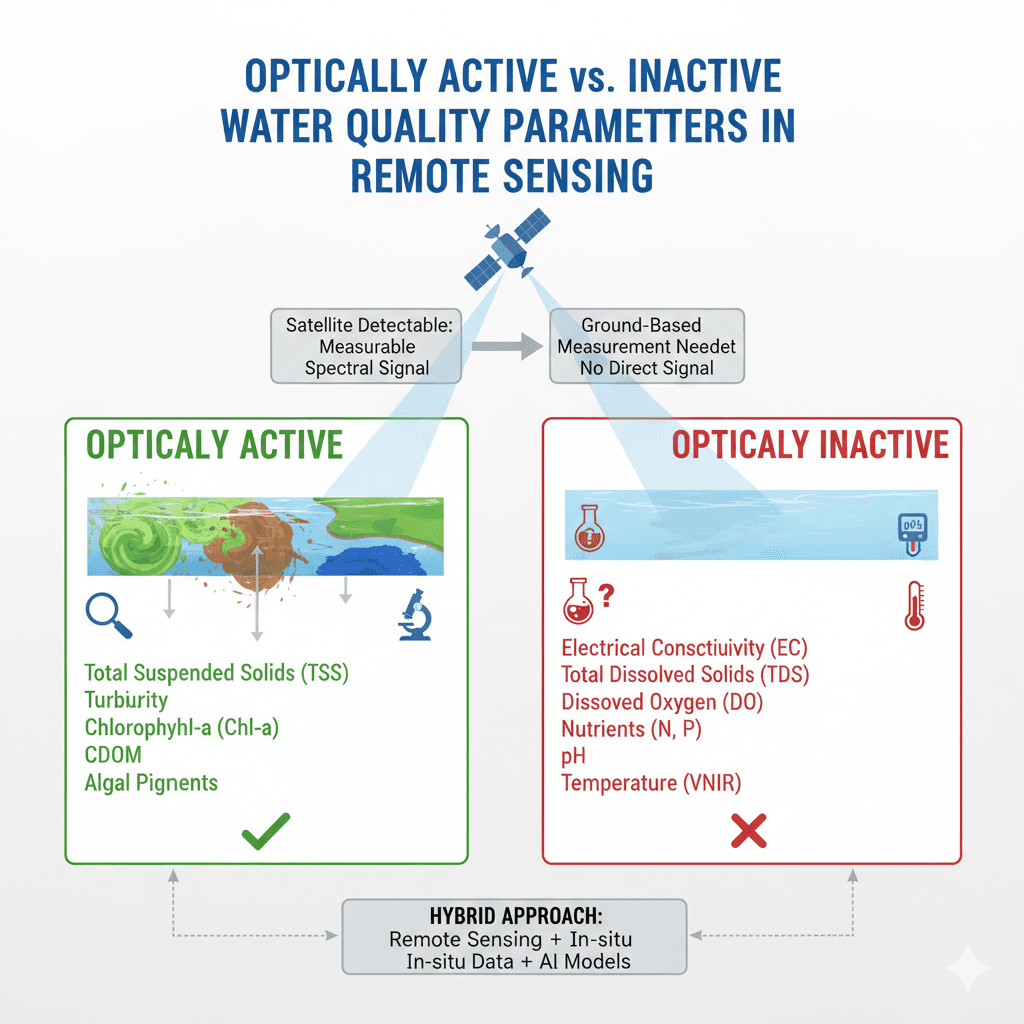Monitoring the quality of rivers, lakes, and coastal waters has traditionally relied on field sampling and laboratory tests. While these methods are accurate, they are also expensive, time-consuming, and spatially limited. This is where remote sensing (RS) offers a game-changing solution: satellites and drones can provide continuous, large-scale observations of water bodies.
However, not all water quality parameters can be directly detected from space. In remote sensing, we classify water quality indicators into two categories: optically active and optically inactive.
What Do We Mean by “Optically Active”?
In physics, optical activity usually refers to a material’s ability to rotate polarized light due to chirality. But in the remote sensing of water quality, the meaning is broader:
- Optically Active Parameters → those that directly absorb or scatter light, leaving a measurable signal in satellite reflectance.
- Optically Inactive Parameters → those that do not directly interact with light and therefore cannot be sensed from space, although they may correlate with optically active variables.
Examples of Optically Active Parameters
These are the stars of satellite water quality monitoring:
- Total Suspended Solids (TSS): Sediments and organic particles scatter light, making turbid water appear brighter in the visible and NIR spectrum.
- Turbidity: Closely linked with TSS, easily mapped using reflectance.
- Chlorophyll-a (Chl-a): A pigment in algae, strongly absorbing in the blue and red regions while reflecting in green and NIR.
- Colored Dissolved Organic Matter (CDOM): Absorbs strongly in the blue–UV region, lowering reflectance at short wavelengths.
- Algal Pigments (e.g., phycocyanin, carotenoids): Detectable with hyperspectral sensors thanks to their unique absorption features.
Examples of Optically Inactive Parameters
These are essential for water quality but remain “invisible” to satellites:
- Electrical Conductivity (EC) and Total Dissolved Solids (TDS): Measure ionic concentrations, but salts and ions do not scatter or absorb visible light.
- Dissolved Oxygen (DO), Biological Oxygen Demand (BOD), and Chemical Oxygen Demand (COD): Crucial ecological indicators, but require in-situ measurement.
- Nutrients (Nitrate, Nitrite, Ammonium, Phosphate): At natural concentrations, they do not leave a detectable spectral signature, although they may trigger algal blooms that are optically active.
- pH: No direct optical impact, but it influences the solubility of other optically active substances.
- Temperature: Detectable only in the thermal infrared (TIR), not through visible or NIR reflectance.
Why Does This Matter?
Understanding which parameters are optically active or inactive helps researchers, policymakers, and water managers design effective monitoring systems:
- Satellites can provide near real-time maps of TSS, turbidity, chlorophyll, and CDOM.
- Inactive parameters still require ground-based measurements, but their indirect links with active parameters can sometimes be exploited through statistical or machine learning models.
This hybrid approach—combining remote sensing + in-situ data + AI models—is the future of large-scale water quality assessment.
Quick Reference Table
| Category | Parameter | Optical Status | Detectability by Remote Sensing |
|---|---|---|---|
| Optically Active | TSS, Turbidity, Chlorophyll-a, CDOM, Algal pigments, Secchi depth | ✅ Active | Strong absorption/scattering, measurable spectral signals |
| Optically Inactive | EC, TDS, DO, BOD, COD, Nutrients, pH, Temperature (in VNIR) | ❌ Inactive | No direct spectral signal (except temperature in TIR) |




